Effective Sandbag Training
Josh Henkin, CSCS, RKC
June 10, 2005 07:55 AM
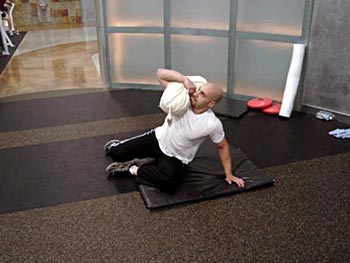
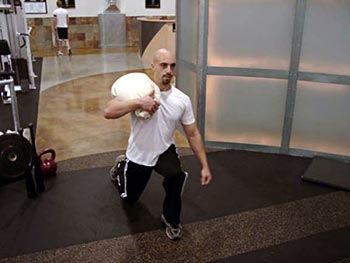
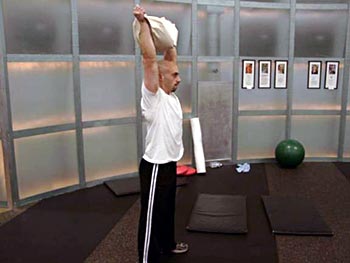
To be able to train in today's times is such a great advantage. Not only do we have the ability to get information instantaneously, but we also have a greater variety of training equipment available than ever before. Sure, some equipment is more beneficial than other, but our choices seem limitless. By having so many different options, it encourages the fun factor in training that many people tend to forget about.
Often we spend a lot of time arguing over the perfect rep and set scheme, or should we use a slightly pronated or semi-supinated grip to optimize effectiveness. While some of these factors definitely prove to be necessary, one cannot discount the benefit of enjoying what training can do for performance. Training will make someone work harder, be more consistent, and as long as the program has rhyme and reason, it will lead to some outstanding gains.
One type of training that sometimes gets forgotten is sandbag training. Sandbags are easy to learn, challenge the whole body, and have more versatility than almost any other form of equipment.
Why Use Sandbags?The most obvious seems to be the simplicity of their use. One does not need to invest hundreds of dollars into coaching (although I am available for those who are interested) or have to read any complicated books. Grasp, rip, and lift. You definitely want to pay attention to your lifting posture, but outside of that most of the fun is trying to figure out how to lift the bag.
Sandbag lifting shares a lot in common with kettlebells with regard to their ability to challenge not only strength, but endurance as well. A good bag will force the lifter to maneuver and adjust to the awkward weight. This definitely causes the body to use more muscles and expend greater energy as it is hard to get into one consistent groove.
Increasing grip strength is another great reason to use sandbags. There is no piece of equipment that frustrates people as much as sandbags. Why? When using sandbags there is no convenient place to grab. You have to constantly search for an open spot and then crush grip. However, unlike most pieces of equipment, I find that not only is your crushing grip challenged, but your pinching grip is as well. For those who are into grip training, you will appreciate the distinct difference between the two.
Versatility is important when choosing any form of equipment. With common concerns about money and time it is often silly to invest a great amount of money into something that has limited use. Not only are sandbags cheap, but they can be used for any movement that you can think of from common gym exercises like squats, clean & jerks, to jogging, climbing, dragging, and throwing. With such variety it is hard to get bored. Along with the various exercises come the many holding positions one can use with sandbags. If squatting is getting too easy with the bag on both shoulders go to one shoulder, hold it overhead, hold it in your arms like a Zercher, bear hug, etc. You are really only limited by your imagination.
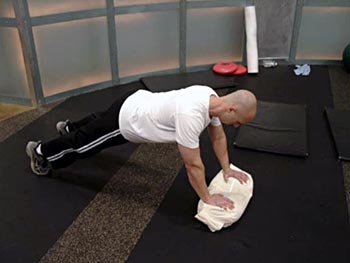
Sandbags easily lend themselves to team or group training. Because of their cost and transportability, they are easy to set up for small or large groups. This is great for those who wish to combine strength and field work and are concerned about time issues. Coaches can concentrate on full-body lifts and challenge various motor qualities such as maximal strength, endurance, and power development.
Finally, the immense amount of trunk training that occurs with sandbag training alone is almost a good enough reason to use them. Try to squat, run, lunge, jump, or any other movement while holding the sandbag/s in various positions. Doing so challenges all of the trunk muscles. Many of my clients will comment how sore they are deep in their rib area after initially using sandbags. Don't believe me? Try a few sets of sandbag Turkish get-ups and then e-mail me how you are feeling!
How to Implement SandbagsAs with any other form of training, sandbags training really comes down to one's goals. If maximal strength, endurance, or speed are your specific goals, then the program has to be designed according to good training principles. However, one can try to improve several components if the program is designed appropriately.
- Circuits: Since fatigue can be somewhat specific, creating a program that emphasizes strength on a lift such as a squat can be followed with relatively short rest by an exercise like an overhead press, and so on.
- Density Training: Several great coaches like Ethan Reeve and Charles Staley have written extensively about the benefits of density work. There are several variants such as Charles Staley's EDT program. Using Coach Staley's program, we can set up a sandbag routine using a squat with the bag over both shoulders and power clean and jerk. Use a weight you can hit ten repetitions with, but you are only going to be performing sets of five. Set a time frame, approximately fifteen minutes, and alternate between these two exercises using only as much rest as needed.
You don't have to use only sandbags. In fact, I highly encourage that you use a variety of implements in your training hopefully including sandbags. A tool such as a sandbag can be used instead of a standard barbell or dumbbell lift such as squats, deadlifts, clean & jerks, presses, rows, etc. By changing the implement some new neural stimulus can often lead to new gains when you go back to the standard lift.
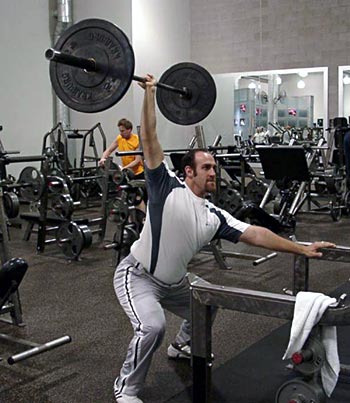 "By changing the implement some new neural stimulus can often lead to new gains when you go back to the standard lift," says Josh Henkin.
"By changing the implement some new neural stimulus can often lead to new gains when you go back to the standard lift," says Josh Henkin.Another option is to use sandbags as a form of active recovery. You can easily change the load to enhance a motor skill and keep mobility without excessively taxing the body. Using a lighter load for your squat will allow you to enhance the groove of the lift and maintaining flexibility without draining the body from the core routines. Odd lifts such as squatting with the bag on one shoulder can increase core strength that may compliment your squatting routine.
Some lifts are just a great overall new challenge such as the Turkish get-up bear hugging a bag. While as sick as this may sound, it can definitely stimulate the fun factor that may help training once again.
With so many options sandbags are a simple and easy method and tool to implement. It isn't a miracle technique but will challenge you in new ways and again don't underestimate the fact fun while training can bring a world of new progress!
Josh Henkin, RKC, CSCS is the owner/director of Advanced Athletic Performance, LLC in Phoenix, Arizona. His company is dedicated to helping people achieve the extraordinary. You can email him at aaptraining@lycos.com or visit www.aaptraining.net
Back